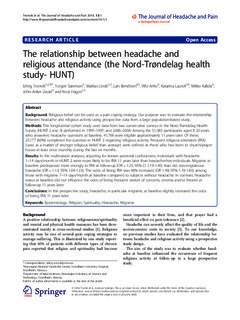| dc.contributor.author | Tronvik, Erling | |
| dc.contributor.author | Sørensen, Torgeir | |
| dc.contributor.author | Linde, Mattias | |
| dc.contributor.author | Bendtsen, Lars | |
| dc.contributor.author | Artto, Ville | |
| dc.contributor.author | Laurell, Katarina | |
| dc.contributor.author | Kallela, Mikko | |
| dc.contributor.author | Zwart, John-Anker | |
| dc.contributor.author | Hagen, Knut | |
| dc.date.accessioned | 2019-10-29T09:27:54Z | |
| dc.date.available | 2019-10-29T09:27:54Z | |
| dc.date.created | 2014-01-07T15:12:07Z | |
| dc.date.issued | 2014 | |
| dc.identifier.citation | The Journal of Headache and Pain. 2014, 15 (1), . | nb_NO |
| dc.identifier.issn | 1129-2369 | |
| dc.identifier.uri | http://hdl.handle.net/11250/2625051 | |
| dc.description.abstract | Background
Religious belief can be used as a pain coping strategy. Our purpose was to evaluate the relationship between headache and religious activity using prospective data from a large population-based study.
Methods
This longitudinal cohort study used data from two consecutive surveys in the Nord-Trøndelag Health Survey (HUNT 2 and 3) performed in 1995–1997; and 2006–2008. Among the 51,383 participants aged ≥ 20 years who answered headache questions at baseline, 41,766 were eligible approximately 11 years later. Of these, 25,177 (60%) completed the question in HUNT 3 regarding religious activity. Frequent religious attendees (fRA) (used as a marker of stronger religious belief than average) were defined as those who had been to church/prayer house at least once monthly during the last six months.
Results
In the multivariate analyses, adjusting for known potential confounders, individuals with headache 1–14 days/month in HUNT 2 were more likely to be fRA 11 years later than headache-free individuals. Migraine at baseline predisposed more strongly to fRA at follow-up (OR = 1.25; 95% CI 1.19-1.40) than did non-migrainous headache (OR = 1.13; 95% 1.04-1.23). The odds of being fRA was 48% increased (OR 1.48; 95% 1.19-1.83) among those with migraine 7–14 days/month at baseline compared to subjects without headache. In contrast, headache status at baseline did not influence the odds of being frequent visitors of concerts, cinema and/or theatre at follow-up 11 years later.
Conclusions
In this prospective study, headache, in particular migraine, at baseline slightly increased the odds of being fRA 11 years later. | nb_NO |
| dc.language.iso | eng | nb_NO |
| dc.publisher | BioMed Central | nb_NO |
| dc.rights | Navngivelse 4.0 Internasjonal | * |
| dc.rights.uri | http://creativecommons.org/licenses/by/4.0/deed.no | * |
| dc.title | The relationship between headache and religious attendance (the Nord-Trøndelag health study-HUNT) | nb_NO |
| dc.type | Journal article | nb_NO |
| dc.type | Peer reviewed | nb_NO |
| dc.description.version | publishedVersion | nb_NO |
| dc.source.pagenumber | 7 | nb_NO |
| dc.source.volume | 15 | nb_NO |
| dc.source.journal | The Journal of Headache and Pain | nb_NO |
| dc.source.issue | 1 | nb_NO |
| dc.identifier.doi | 10.1186/1129-2377-15-1 | |
| dc.identifier.cristin | 1085363 | |
| dc.description.localcode | Open Access This article is distributed under the terms of the Creative Commons Attribution 2.0 International License (https://creativecommons.org/licenses/by/2.0), which permits unrestricted use, distribution, and reproduction in any medium, provided the original work is properly cited. | nb_NO |
| cristin.unitcode | 194,65,30,0 | |
| cristin.unitcode | 1920,16,0,0 | |
| cristin.unitname | Institutt for nevromedisin og bevegelsesvitenskap | |
| cristin.unitname | Nevroklinikken | |
| cristin.ispublished | true | |
| cristin.fulltext | original | |
| cristin.qualitycode | 1 | |

